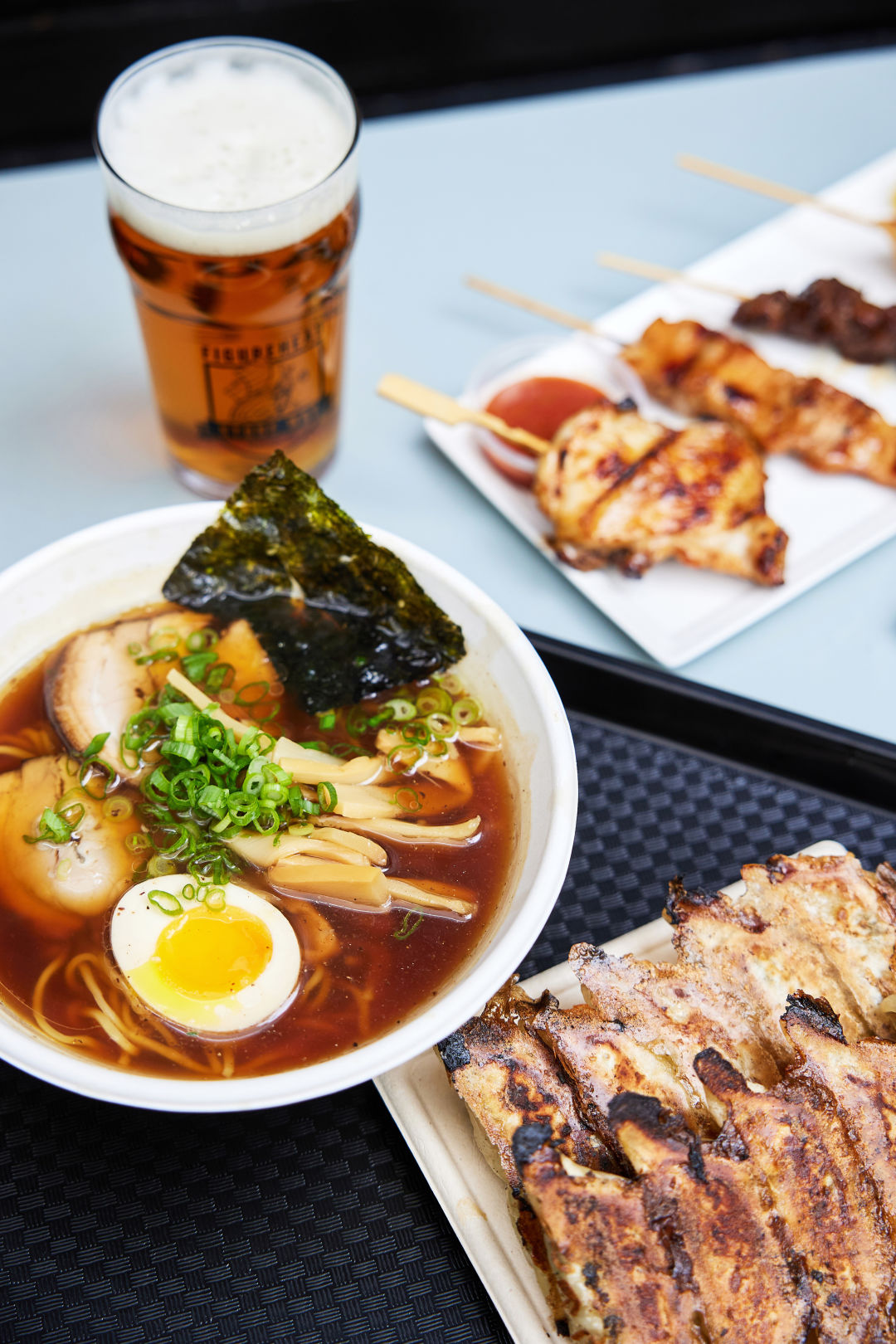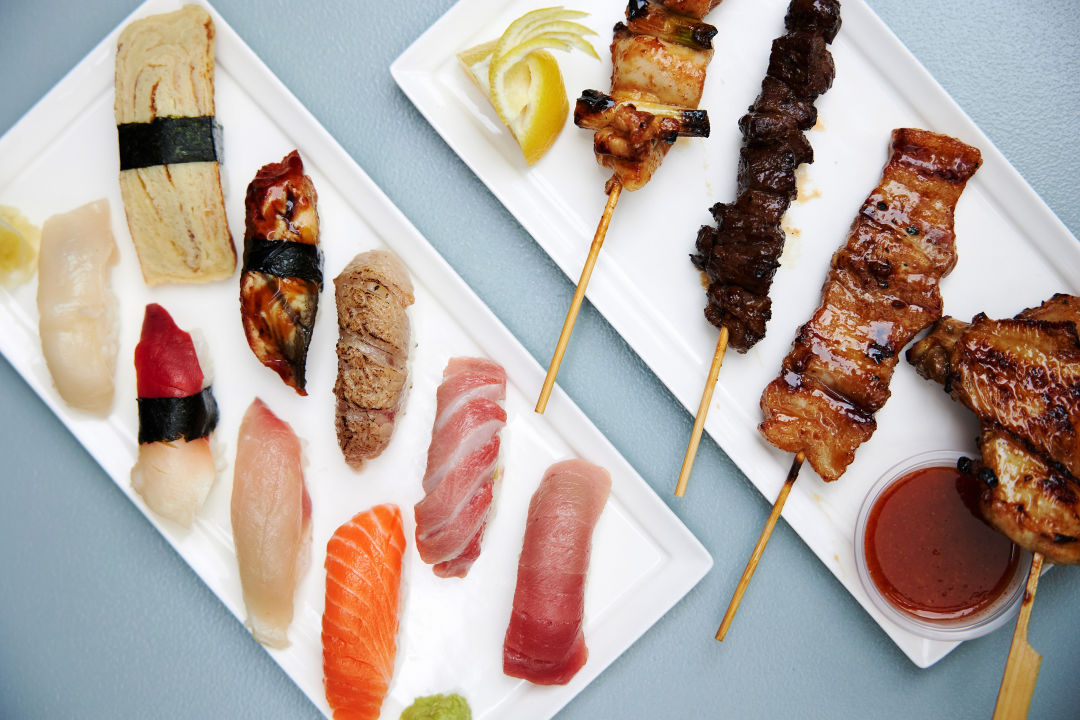
Ramen, gyoza, beer, and yakitori all come collectively at Figurehead Brewing’s Fremont taproom.
On the Olympics this yr, the world watched American pommel horse phenomenon Stephen Nedoroscik display the facility of specialization. As his gymnast teammates flung themselves by way of vaults, bounced by way of flooring routines and spun round bars, Nedoroscik channeled each ounce of his ability, coaching, and vitality into his single occasion.
Elmer Komagata is the pommel horse man of ramen.
In growing the menu for Midnite Ramen, Komagata labored with a producer in Japan to customise par-cooked noodles that prepare dinner to his actual desired texture in simply 15 seconds, so he can put together orders on his tiny truck. He used his a long time of fine-dining expertise to plan ethereal broths that really feel gentle on the tongue whereas remaining wealthy with taste.

Elmer Komagata and his spouse, Izumi, of Midnite Ramen.
However when he moved his cart to a everlasting location with an on-site commissary kitchen, like America’s nerdiest double medalist, Komagata wanted to construct a talented group round him.
In April, Figurehead Brewing opened an outpost of its Magnolia Brewery on Stone Means in Fremont. Komagata parked his Midnite Ramen trailer inside, only a few steps from the commissary kitchen he now shares with Ooshiba Yakitori and Sushi.

Technically a catering enterprise providing takeout meals, Ooshiba Yakitori & Sushi operates from Midnite Ramen’s commissary kitchen behind Figurehead’s taproom.
Every operates as a separate enterprise, which implies to get myself a bowl of Komagata’s spicy miso ramen, sticks of Ooshiba’s infinitely tender rooster meatballs for my youngsters, and my husband a pint of Figurehead’s West Wall Session IPA, I wanted to put three completely different orders in three completely different locations.
I added a fourth cease (and a 3rd little black pager that beeped to alert me when my meals was prepared) once I needed to attempt the schnitzelesque crispy ji-pai fried rooster and delicate, octopus-filled takoyaki which Komagata serves from his personal commissary kitchen, 15 ft from the cart. The gyoza, for which Komagata has a devoted specialist educated and solely centered on, has an entire different ticketing system.
Confused? You’re not alone. “That is in all probability been the largest hurdle that we have had,” says Bob Monroe of Figurehead. A maze of bureaucratic allowing and licensing rules formed the setup, which is a little bit of a logistical nightmare. However for everybody concerned—Monroe, Komagata, and greater than something, Seattleites hungry for a wide range of wonderful Japanese meals—it’s a dream come true.
Cart Tradition
The tradition of little family-owned meals carts in Japan referred to as yatai has virtually utterly disappeared since Komagata shaped fond childhood reminiscences of consuming late-night ramen at them.
Komagata left Japan in 1984 and cooked his means by way of the Michelin-starred kitchens of France. He landed in Los Angeles as Ruth Reichl chronicled the rise of fusion eating places and California delicacies within the Nineteen Nineties. Then he moved on, operating the eating applications for large inns in Mexico for 14 years. With every step, his imaginative and prescient solidified: he needed to share the traditions of the yatai, and—after visiting a pal right here—he knew he needed to do it in Seattle.

Midnite Ramen’s yatai-style meals cart is permanantly parked within the breezeway between its personal commissary kitchen and Figurehead Brewing’s taproom.
Following a fast cease to open a ramen store in Southern California, Komagata moved to Seattle in 2015 and began working towards his downsizing dream: going from managing a 120-person kitchen to creating simply 120 bowls of ramen an evening, alongside his spouse, Izumi.
In 2020, he completed outfitting a seven- by 10-foot trailer with the crimson noren cloth curtains and pop-out bar typical of yatai. He studied ramen varieties and strategies from round Japan and used that to compose his menu: ’50s-style traditional ramen from Tokyo, onomichi from Hiroshima, which makes use of an anchovy broth slicked with pork fats, and the signature Kumamoto Miso Daring with blackened garlic and chili oil. As an alternative of the milky, wealthy pork broths stylish within the US on the time, he included clarifying strategies from French delicacies and constructed taste utilizing Chinese language preserved greens to make a base broth that was gentle and clear.
At 65, Komagata was considerably older than most individuals beginning a meals cart. And whereas most of them need to park exterior breweries, all he needed was to park inside one. For 3 and a half years, Midnite Ramen made it work, parking exterior Figurehead’s Magnolia location and Obec Brewing in Ballard. The grueling work of cooking, transporting, and promoting at breweries restricted Komagata’s capability throughout that point. Nevertheless it was solely step one.
Nicely Linked
Parking exterior Figurehead three nights every week, Komagata bought to know Monroe fairly effectively, filling him in on his dream to recreate the yatai tradition with slightly cluster of Japanese road meals companies.
When Figurehead started planning its personal enlargement two years in the past, they regarded on the panorama of breweries in Seattle and requested themselves what was lacking. “Most breweries do not have in-house meals, or actually good meals on premise,” says Monroe. “They’re centered on beer.”
They invited Komagata to make the plan for the kitchen.
The Fremont area technically spans two buildings; the primary is all Figurehead, an extended, vast room typically crammed with households and massive teams, very like every other taproom on the town. However towards the again, the room narrows to a breezeway, the place Komagata’s yatai-style cart now lives. Persevering with again, it opens up once more. Alongside the north wall sits a pair of digital kiosks for ordering, the kitchen takes up a lot of the remainder of the room.

Ooshiba provides yakitori and sushi to the menu, but in addition provides to the confusion.
Midnite Ramen operates like every other meals truck or cart on the town, getting ready meals in a commissary kitchen, then transporting it to the cellular unit for serving. The distinction right here is that the cart is only a few steps from the kitchen and doesn’t go wherever.
Discovering himself with loads of kitchen area and never fairly sufficient capital, Komagata regarded to ease his prices by inviting Ooshiba Yakitori and Sushi to hire area within the commissary kitchen. Komagata met sushi chef Hiroshi Kakuta and his pal Hirotaka Muramstsu when he first moved to Seattle, in 2015, by way of a consulting job at Sushi Kashiba.
Within the years since, Muramatsu had realized that Seattle lacked a great yakitori restaurant. A pal in Tokyo with a yakitori stand despatched him a recipe, and “The 2 Hiros” created Ooshiba, grilling up skewers of glazed rooster, bites of glistening pork, and assortments of contemporary sushi. Beginning in 2022, Ooshiba arrange as a popup alongside Midnite Ramen at Figurehead’s Magnolia Taproom, then made the bounce with Komagata to Fremont.
Now Pouring
In April, Figurehead opened its Fremont Taproom. When Midnite Ramen, Ooshiba, and the commissary kitchen are all cranking, the again room takes on an air of pleasure, like an evening market, as folks bustle forwards and backwards to retrieve their orders. The meals work effectively collectively, and it’s enjoyable to snack on a stick of charred shishito peppers whereas ready for a bowl of ramen.
Komagata and Ooshiba stagger their days off, making certain Japanese road meals each evening of the week. Figurehead added drinks that match with the Japanese meals, with a sake assortment, loose-leaf tea sourced from Ballard’s Floating Leaves Tea, and even the Japanese soda, Ramune. Extra confusingly, Figurehead has its personal meals menu, too, although Monroe downplays that: they should have it as a result of they’ve a restaurant license, and thus should serve meals.

Komagata lives out his dream of making a yatai village in Seattle from his ramen cart.
Midnite Ramen and Ooshiba are technically a separate enterprise, in order that they don’t rely, and the confusion that creates frustrates Monroe. “We’re huge on interactions with clients, constructing that sense of neighborhood, and creating connections,” he says. He doesn’t care if company are available in for less than Komagata’s meals, he simply needs they wouldn’t ignore his servers, particularly if the setup confuses them. “My workers is tremendous useful,” says Monroe. “Come discover certainly one of my bartenders; they’d fortunately return and present you the place to order and how you can do it.”
In fact, that is Seattle and that may require speaking to folks. Which circles again to Monroe’s authentic intention for the taproom: to attach with folks. It’s the rising pains of a brand new enterprise mannequin, one which Komagata is proud to pioneer. “[We are] experiencing a ache of giving a child delivery,” he tells me. As a mom of two, I obtain that with slightly skepticism. However I’ve extra religion in what he says subsequent: “I imagine this enterprise mannequin is likely one of the options to outlive.” The cooperation between the three corporations makes issues a bit difficult for the diner, however so much simpler for small entrepreneurs.
The various choices additionally made it simpler to seek out one thing my youngsters needed to eat, making dinner really feel much less like a grueling Olympic competitors than regular. Although, if I had been awarding such issues, I might give Figurehead a gold medal in family-friendliness for the bowl on their counter inviting youngsters to seize a free Pokémon card.

